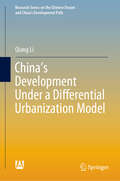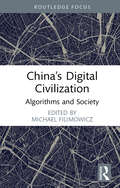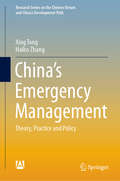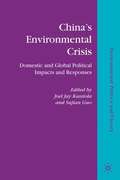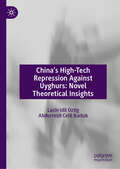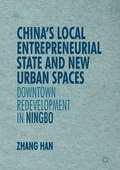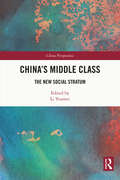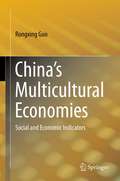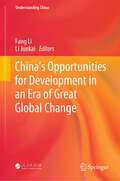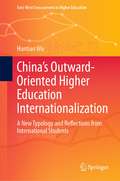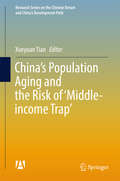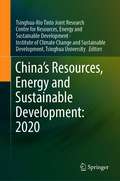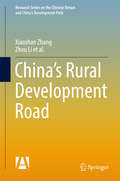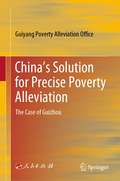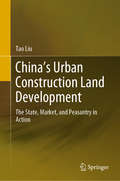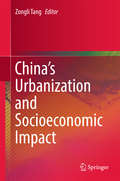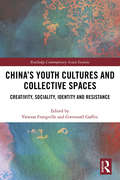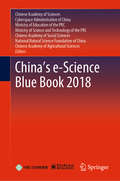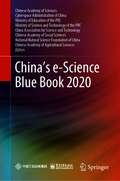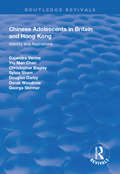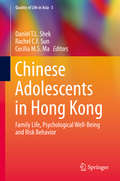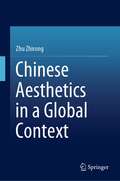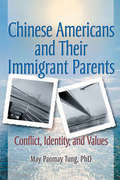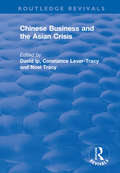- Table View
- List View
China’s Development Under a Differential Urbanization Model (Research Series on the Chinese Dream and China’s Development Path)
by Qiang LiThis book analyses the particular nature, characteristics and current conditions of urbanization in China. It reviews the theory of “urbanization with a diversified process” and puts forward the basic principles for promoting urbanization on the basis of a perspective reflecting the diversified sizes of towns and cities. Further, it assesses the overall strategic planning for advancing urbanization and explores the characteristics of an urban society formed on the basis of diversified urbanization.
China’s Digital Civilization: Algorithms and Society (Algorithms and Society)
by Michael FilimowiczThis book focuses on the ‘algorithmic turn’ in state surveillance and the development of new platforms that allow the Chinese Communist Party to shape human behaviour in all areas of life through its widespread social credit system. Perhaps no country has gone further than China in setting up overt systematic tracking, surveillance and constant computational evaluation of its citizens. Everyday life is saturated with a pervasive digitization that affects social mobility, economic opportunities and personal freedoms. Global organizations operating in China have to take account of the ramifications of these systems for data protection within the CCP’s explicit project of forming a digital civilization. The volume covers the new technological practices that have transformed how states acquire and analyze personal data, the ‘TikTok-ification’ of society as social credit platforms built on the familiarity with this popular app’s interaction paradigm, and the fast expansion of the digital economy that followed the new legal status of data as a production component in 2019. Scholars and students from many backgrounds, as well as policy makers, journalists and the general reading public will find a multidisciplinary approach to questions posed by research into China’s digital civilization project from Media, Journalism, Communication and Global Studies.
China’s Emergency Management: Theory, Practice and Policy (Research Series on the Chinese Dream and China’s Development Path)
by Xing Tong Haibo ZhangIn this timely book about the current state of research and practice of emergency management in China, the authors take as their basic premises that we now live in a risk society and that our collective ability to deal with disasters and their aftermath is more important than ever. Set within a multi-disciplinary framework that places risk, disaster and crisis, the three phases of emergency management, on an analytical continuum, and drawing on empirical data obtained through surveys, observations, and interviews, the study not only provides a thorough overview of recent progress in our theoretical understanding of the subject but also offers insights on how scientifically informed policies can improve the way emergency management is done in China.
China’s Environmental Crisis
by Sujian Guo Joel Jay KassiolaThis path-breaking collection covers the significance of China's extreme environmental challenges for both Chinese society and the world, how these challenges are impacting domestic Chinese society and its political institutions, and how these institutions are responding in their efforts to address the environmental problems.
China’s High-Tech Repression Against Uyghurs: Novel Theoretical Insights
by Lacin Idil Oztig Abdurresit Celil KarlukThis book explores the socio-spatial impacts of China’s high-tech repression against Uyghurs both within and beyond its borders. The study is built on surveys, in-depth interviews, and focus group discussions with the members of Uyghur diaspora in Türkiye. Findings indicate that high-tech repression minimizes the social life in East Turkestan. This type of governance aims to achieve a complete erasure of privacy and individual agency by strategically leveraging technology. While Uyghurs who escaped to Türkiye appear to gain relative freedom, our findings indicate that with China’s transnational repression mostly applied through Information and Communication Technologies (ICTs), they live in a social space which functions as a quasi-spatial extension of East Turkestan.
China’s Hong Kong: A Political and Cultural Perspective (China Academic Library)
by Shigong JiangThis book differs from most others of its kind, by looking at the Hong Kong issue from China's perspective, which in turn mirrors China's own situation. Through a legal lens, the author conducts a political and cultural examination of the past and the present, and provides a comprehensive overview of the many theories and problems concerning Hong Kong. Including reflections on the theory of administrative absorption of politics, a historical review of "one country, two systems" and an analysis of the form and nature of the Basic Law, it offers a valuable reference resource for studying the historical, political and legal context of Hong Kong under the principle of "one country, two systems". Instead of over-simplifying the issue of Hong Kong or only seeing it as a Chinese regional issue, the book regards it as a central Chinese issue and the key to understanding China.
China’s Local Entrepreneurial State and New Urban Spaces: Downtown Redevelopment in Ningbo (New Perspectives on Chinese Politics and Society)
by Han ZhangIn this book, the author seeks to understand China’s urban redevelopment from the theoretical perspective of the local entrepreneurial state. China’s rapid socio-economic transformations since 1978 have been in large part attributed to China’s state transformations. The author closely investigates Ningbo’s two downtown redevelopment projects by conducting ethnographic fieldwork and documentary research. It is found that the local entrepreneurial state deploys local state enterprises to undertake strategic urban redevelopment projects, organizes high-profile city/district marketing campaigns in entrepreneurial manners, and develops corporatist intermediations with local business owners for collaborative urban governance. Yet the local entrepreneurial state is multi-layered, with the municipal and district authorities sometimes disagreeing, conflicting, and bargaining with each other. Meanwhile, the relationship between spaces and their users, as well as that between various space users, constantly changes. All these players and their interactions constitute “spatial politics”, or the story of conflicts, struggles, negotiations, and collaborations in urban governance. This work, based on six months of fieldwork, will appeal to scholars in the social sciences and experts in Asian Studies.
China’s Middle Class: The New Social Stratum (China Perspectives)
by Li YoumeiThis book is a collection of empirical studies on China’s middle class from top-ranking Chinese sociologists, discussing this newly identified social stratum with regard to the basic concept and scope of the group, its functions, formation, identity, consumption, behavior patterns and value system. As the first study of its kind, the analysis of most chapters is based on a rich body of empirical data gathered from rigorous large-scale surveys designed specifically for the Chinese middle class across megacities including Beijing, Shanghai and Guangzhou. The book traces the complex and dynamic formation process of China’s middle class from different perspectives while dealing with issues of social concern such as “rigid social stratification”. The findings shed light on the underlying logic of structural change in Chinese society over several recent decades, with significant policy implications. The book will attract sociologists, students and policymakers interested in social structure, social transformation and middle-income groups in China.
China’s Multicultural Economies: Social and Economic Indicators
by Rongxing GuoAlthough the majority of China's population is of the Han nationality (which accounts for more than 90% of China's population), the non-Han ethnic groups have a population of more than 100 million. Until now, China has officially identified, except for other unknown ethnic groups and foreigners with Chinese citizenship, 56 ethnic groups. In addition, ethnic groups vary widely in size. With a population of more than 15 million, the Zhuang have the largest ethnic minority, and the Lhoba, with only two thousand or more, the smallest. China's ethnic diversity has resulted in a special socioeconomic landscape of China itself. This book develops a complete socioeconomic picture and a detailed and comparable set of data for each of China's ethnic groups. There have not been any precise data on China's socioeconomic statistics from multi-ethnic dimension. The only official data released can be found in China Ethnic Statistical Yearbook (released by the State Commission of Ethnic Affairs (SCEA) of the People's Republic of China since 1994). However, as this Yearbook has only reported the socioeconomic statistics for the minority-based autonomous areas, a complete set of China's multi-ethnic data cannot be derived from it. This book provides a broad collection of data on China's 56 ethnic groups and profiles the demography, cultural, economy, and business climates for each of China's diverse ethnic groups.
China’s Opportunities for Development in an Era of Great Global Change (Understanding China)
by Fang Li Li JunkaiThis book interprets China's development and the opportunities it can leverage in the context of unprecedented change and the COVID-19 pandemic. It aims to provide case studies and insights for researchers and offer authoritative information for those interested in China’s development. In this book, 20 distinguished experts and researchers contribute their wisdom around five topics: science and technology innovation, ecological environment, the global and Chinese economies, high-tech industry development, and international and Chinese media research.
China’s Outward-Oriented Higher Education Internationalization: A New Typology and Reflections from International Students (East-West Crosscurrents in Higher Education)
by Hantian WuThis book introduces a new typology of “inward- and outward-oriented” higher education internationalization, and investigates China’s current situation of shifting from a mainly “inward-oriented” higher education internationalization to a more balanced approach. It describes the gap between China’s soft power goals of using higher education internationalization for image and influence enhancement and the reality, and examines the three major dimensions of China’s “outward-oriented” higher education internationalization (i.e. the Confucius Institute program based on Sino-foreign higher education collaboration, international development aid in higher education, and higher education level international student recruitment) based on reflections provided by international graduate students in English instruction programs in education-related majors in three Chinese universities. Providing both theoretical insights and real-world examples, this book is suitable for higher education researchers, graduate students in the relevant fields, administrators of higher education institutions, and policymakers in the government sector.
China’s Population Aging and the Risk of ‘Middle-income Trap’ (Research Series on the Chinese Dream and China’s Development Path)
by Xueyuan TianThis book includes a series of reports that mainly discuss the Middle Income Trap against the backdrop of population ageing in China. It also offers practical suggestions on how to avoid it properly. Concretely, it argues that the government should accelerate the transition of economic development modes, resolve concentrated social conflicts, promote a balanced rural and urban development during the process of urbanization, and mitigate the effects of population ageing by fostering strengths and avoiding weaknesses. As for the challenges posed by population ageing in China, it puts forward five core suggestions tailored to China's unique situation. Assessing a number of real-world challenges, the general report and the special reports combine theory and empirical findings, using primary data for their analyses. Given the wealth of essential information it provides, the book offers a valuable reference resource for decision-makers.
China’s Resources, Energy and Sustainable Development: 2020
by Tsinghua-Rio Tinto Joint Research Centre for Resources, Energy and Sustainable Development Institute of Climate Change and Sustainable Development, Tsinghua UniversityThis book explores sustainable development from the perspective of resources and energy, based on China’s practical experience and cross-disciplinary research. It focuses on major challenges, key solutions and policy recommendations, and studies and explores seven important themes of resources, energy and sustainable development, including: 1) China’s low-carbon energy transition, 2) China’s urbanization and low-carbon development, 3) China’s low-carbon action in cities, 4) China’s low-carbon power transition, 5) China’s water resources management, 6) electric vehicle development and key metal resources and 7) China’s low-carbon development of the iron & steel industry. This book contributes to a more integrated understanding of many themes and their relationships in the area of resources, energy and sustainable development and guides the related policy and management.
China’s Rural Development Road (Research Series on the Chinese Dream and China’s Development Path)
by Zhou Li Xiaoshan ZhangThis book systematically reviews the experiences and problems encountered in the development of China's rural areas over the past three decades since the start of the country's economic reform. As such, it addresses the most important aspects in terms of China's rural communities, farmers and agriculture from the perspective of development, such as the agricultural management system, rural land tenure system, rural fiscal and taxation system, financial system, science and technology system, rural governance structure, poverty alleviation, environmental protection, etc. The approach employed combines essential theories, laws, and policy strategies with rural development practice in order to analyze the success stories and lingering problems, to explore the causes of both, and to offer an outlook on the future of rural development.
China’s Solution for Precise Poverty Alleviation: The Case of Guizhou
by Guiyang Poverty Alleviation OfficeThis book select successful cases of poverty reduction and alleviation in the Guizhou province of China, which reflects the highest number and widest distribution of people living in poverty. The local government seeks to achieve sustainable development goals and find multiple solutions to the problem.. The book introduces local experiences and presents the whole process from policy making to practice.
China’s Urban Construction Land Development: The State, Market, and Peasantry in Action
by Tao LiuThis book examines the nature and internal dynamics of China’s urban construction land (UCL) development, drawing insights from the recently developed theory of regional political ecology. Based on the author’s original research, it identifies two different types of UCL development in China, namely top-down, formal development in the legal and regulated domain, and spontaneous and informal, bottom-up development in the semi-legal, poorly regulated gray domain. Presenting a systematic analysis and comparison, it reveals a scale and speed of informal land development no less significant than that of formal land development, although informal land development tends to be scattered, pervasive, difficult to track, and largely overlooked in research and policy formation. Contrary to the popular perception of the peasantry as passive victims of land development, this book uncovers an intriguing dynamic in which the peasantry has played an increasingly (pro)active role in developing their rural land for urban uses in informal markets. Further, based on an investigation of UCL development in Beijing and Shenzhen, it shows an interesting trajectory in which the uneven growth and utilization of UCL are contingent upon the various developmental milieus in different places. China’s land institutions, based on an urban–rural dual land system, are not conducive to the ultimate goal of saving and efficiently utilizing land. Accordingly, an urban–rural integrated land market and management system is highly advisable. The theoretical and empirical enquiry presented challenges the perceived notion of China’s UCL development as the outcome of market demand and state supply. Further, it argues for an inclusive treatment of the informality that has characterized urbanization in many developing countries, and for a reassessment of the role played by the peasantry in land-based urbanization.
China’s Urbanization and Socioeconomic Impact
by Zongli TangThis book examines the impacts of China's urbanization on the country's economic development, clan culture, rural societies, minority resident areas, natural environment, women, and public policy reforms, drawing on official statistics, independent survey data, archives, and fieldwork research to do so. Adopting a cross-disciplinary perspective, the book places special emphasis on issues that have been neglected in prior studies, and provides up-to-date information, reports, and analyses based on the latest events. Further, it considers future directions and strategies regarding urban development, discusses regional urbanization in selected poor and "backward" western provinces, analyzes changes in traditional clan culture brought on by urbanization, and explores evolutions in local clan societies in the Qin and Han Dynasties when cities expanded and business flourished. Lastly, the book examines the effects of infrastructure-related determinants on urban expansion rates and urban land prices, demonstrates the ebbs and flows of public opinion regarding various environmental issues, discusses planned real estate tax reform, and assesses the impact of demographic and socioeconomic changes on young unmarried women.
China’s Youth Cultures and Collective Spaces: Creativity, Sociality, Identity and Resistance (Routledge Contemporary Asian Societies)
by Vanessa Frangville Gwennaël GaffricPresenting the collaborative work of 13 international specialists of contemporary Chinese culture and society, this book explores the spaces of creation, production, and diffusion of "youth cultures" in China among generations born since the 1980s. Defining the concept of "youth culture" as practices and activities that catalyze self-expression and creativity, this book investigates the emergence of new physical spaces, including large avenues, parks, shopping malls, and recreation areas. Building on this, it also examines the influence of non-physical places, especially digital cultures, such as online social networks, shopping platforms, Cosplay, cyberliterature, and digital calligraphy and argues that these may in fact play a more significant role in Chinese civil society today. As an exploration of how youth can be creative even in a coercive environment, China’s Youth Cultures and Collective Spaces will be valuable to students and scholars of Chinese society, as well those working on the links between space, youth, and culture.
China’s e-Science Blue Book 2018
by Chinese Academy of Social Sciences Chinese Academy of Sciences Cyberspace Administration of China Ministry of Education of the PRC Ministry of Science Technology of the PRC National Natural Science Foundation of China Chinese Academy of Agricultural SciencesThis book is jointly compiled by Chinese Academy of Sciences, Cyberspace Administration of China, Ministry of Education of the People’s Republic of China, Ministry of Science and Technology of the People’s Republic of China, Chinese Academy of Social Sciences, National Natural Science Foundation of China and Chinese Academy of Agricultural Sciences. Over the past several years, Chinese scholars have contributed numerous research works on the development of Chinese scientific information and technology, and produced a range of outstanding achievements. Focusing on the main topic of e-Science, this book explores the forefront of science and technology around the globe, the major demands in China and the main fields in China’s economic development. Furthermore, it reviews the major achievements and the typical cases in China's e-Science research. It provides a valuable reference source for future technological innovations and will introduce researchers and students in the area of e-Science to the latest results in China.
China’s e-Science Blue Book 2020
by Chinese Academy of Social Sciences Chinese Academy of Sciences Cyberspace Administration of China Ministry of Education of the PRC National Natural Science Foundation of China Chinese Academy of Agricultural Sciences Ministry of Science and Technology of the PRC China Association for Science and Technology“China’s e-Science Blue Book 2020” has been jointly compiled by the Chinese Academy of Sciences, Cyberspace Administration of China, Ministry of Education of the PRC, Ministry of Science and Technology of the PRC, China Association for Science and Technology, Chinese Academy of Social Sciences, National Natural Science Foundation of China and the Chinese Academy of Agricultural Sciences. It was focusing on the new situation, new progress and new achievements of China's e-Scientific in the past two years. During the “13th Five-Year Plan” period, Chinese scholars make full use of advanced information technology to carry out scientific research work, and have achieved a series of major scientific and technological achievements. This book has collected 28 research reports about China’s e-Science application in the past two years to introduce the application in the frontier research of science and technology, the progress of e-Science in major projects and the achievements of informatization in interdisciplinary. As such it provides a valuable reference resource for researchers and students in this area and promotes further e-Science research.
Chinese Adolescents in Britain and Hong Kong: Identity and Aspirations (Routledge Revivals)
by Christopher Bagley Gajendra Verma George Skinner Yu-Man Chan Sylvia Sham Douglas Darby Derek WoodrowFirst published in 1999, this book is based on several years work in Hong Kong and Britain, both before and after the absorption of the Special Administrative Region of Hong Kong into the People’s Republic of China in 1997. The initial chapters review the history of Chinese people in Britain; specific aspects of Chinese culture and personality; Chinese educational systems; and the recent history of migration from Hong Kong to Britain. The central part of the book compares three samples of adolescents (about 350 in each of the three cultures): Chinese adolescents in Hong Kong; Chinese adolescents in Britain, with sub-divisions of those who have grown up in Britain and those recently arrived; and Chinese adolescents in Hong Kong. All of the 1,050 respondents completed measures of self-concept, identity, educational aspirations and views about the family, society and the future. The final part of the book contains extended qualitative accounts from personal interview with a sub-sample of Chinese adolescents in Britain and concludes with proposals for educational and policy changes which can accommodate the aspirations of Chinese adolescents in the British educational system.
Chinese Adolescents in Hong Kong: Family Life, Psychological Well-Being and Risk Behavior (Quality of Life in Asia #5)
by Daniel T. L. Shek Rachel C. F. Sun Cecilia M. S. MaThis book documents the findings of a 3-year longitudinal study on the quality of family life, personal well-being and risk behavior in Chinese adolescents in Hong Kong. It presents the profiles of quality of family life (family functioning, parental behavioral control, parental psychological control and parent-child relational qualities); personal well-being (positive youth development and life satisfaction measures) and adolescent risk behavior (substance abuse, delinquency, self-harm and suicidal behavior and behavioral intentions to engage in risk behavior) in different adolescent populations across time. It also examines theoretical issues concerning the interrelationships between family quality of life, psychological well-being and risk behavior in adolescents. Practically speaking, the findings can help youth workers appreciate the importance of family quality of life and positive youth development in shaping the personal well-being and risk behavior in Chinese adolescents in Hong Kong.
Chinese Aesthetics in a Global Context
by Zhirong ZhuThis book examines aesthetic issues based on humanities principles and creates a theory of Chinese aesthetics from a global perspective by applying China’s traditional and cultural history to a Western theoretical framework. In particular, this book emphasizes the shared features of Confucianism, Daoism, and Buddhism, namely the unity of heaven and men, unity of nature and society, and the materialization of human feelings and humanization of material things. It also highlights the dominant role of humans in the aesthetic relationship between human and object, while placing imagery in a focal position.
Chinese Americans and Their Immigrant Parents: Conflict, Identity, and Values
by Terry S Trepper May TungBased on culture-related themes derived from the author's psychotherapeutic work with young Chinese-American professionals, this important book relates personal problems and conditions to specific sources in Chinese and American cultures and the immigration experience. Unique and practical, this is a nonclinical work that will help Asian Americans connect historical and cultural meanings to their Chinese roots. It will also give educators, mental health professionals, and those working with Chinese populations firsthand insight into the lives and identities of Chinese-American immigrants. Exploring the meaning and arrangement of Chinese family names, the bonds among family members, and the different contexts of “self” to Chinese Americans, this valuable book offers you insight into the dilemma between “self” and “family” that both the younger and older generations must face in American society. In order to help you understand Chinese immigrants or help your clients, Chinese Americans and Their Immigrant Parents provides you with information about several differences found between the two cultures, such as: understanding that words and concepts may not relate to the same emotions or translate exactly between languages realizing that strong family bonds of the Chinese fosters interdependence, unlike Americans who admire self-assertiveness and independence recognizing the fear that Chinese immigrant parents have of losing their strong family ties and seeing their children forsake customs because they do not want to be seen as “different” discovering why risk-taking and adventurous acts are discouraged by many Chinese parents comprehending the great importance to Chinese parents of continuing their family and raising successful children acknowledging the different roles of men and women within several different contexts in American and Chinese societiesWith personal vignettes, humor, and interesting insights, Chinese Americans and Their Immigrant Parents: Conflict, Identity, and Values demonstrates how some Chinese Americans are connecting historical and cultural meanings to their Chinese roots and bridging generational gaps between themselves and their parents to create a truly cross-cultural identity.
Chinese Business and the Asian Crisis
by Constance Lever-Tracy Noel Tracy David IpThis title was first published in 2000: The Asian financial crisis and its aftermath provide a crucible in which Chinese diaspora capitalism has been tested, and a prism through which its strengths and weaknesses may be seen in a different light. The papers collected in this volume are in many ways still tentative. Some represent work-in-progress reports on as yet uncompleted research. In other cases, outcomes explored are still unclear or have not even yet fully unfolded. The aim is to focus on the consquences for diaspora Chinese capitalists and to start trying to identify losers and winners in the new landscape, re-evaluating their business culture, strategies and modes of operation, and their likely future direction and potential. The book begins by setting the scene for the Asian crisis and the achievements of the "Asian miracle". It then goes on to examine the causes of the financial crash, the firms that were able to ride the crisis, the Taiwanese economy as a whole, the fortunes of diaspora ventures in China, the small and medium enterprises at the heart of Chinese diaspora capitalism, the impact of the crisis on large Chinese business groups, and finally, the book debunks the theory that the rise of East Asia was initiated by Japan.
